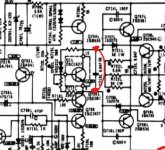Nikko Alpha 2
Hey Thanks for fat reply.... But can you please Explain a bit more on How to override the bias generator to force a zero bias condition.. Plzzz
Hey Thanks for fat reply.... But can you please Explain a bit more on How to override the bias generator to force a zero bias condition.. Plzzz
Nikko Alpha 2
One more question.. So the Complementary Transistor That I Installed would work? Because the Transistor suppose to be a A733 which is a NPN And this is it's Description:
Package Type: TO-92
Transistor Type: PNP
Max Collector Current(IC): -150mA
Max Collector-Emitter Voltage (VCE): -50V
Max Collector-Base Voltage (VCB): -60V
Max Emitter-Base Voltage (VEBO): -5V
Max Collector Dissipation (Pc): 250 miliWatt
Max Transition Frequency (fT): 180 MHz
Minimum & Maximum DC Current Gain (hFE): 90 – 600
Max Storage & Operating temperature Should Be: -55 to +150 Centigrade
The Complementary one I used is C495 which is a NPN, and the values are opposite to the A733
One more question.. So the Complementary Transistor That I Installed would work? Because the Transistor suppose to be a A733 which is a NPN And this is it's Description:
Package Type: TO-92
Transistor Type: PNP
Max Collector Current(IC): -150mA
Max Collector-Emitter Voltage (VCE): -50V
Max Collector-Base Voltage (VCB): -60V
Max Emitter-Base Voltage (VEBO): -5V
Max Collector Dissipation (Pc): 250 miliWatt
Max Transition Frequency (fT): 180 MHz
Minimum & Maximum DC Current Gain (hFE): 90 – 600
Max Storage & Operating temperature Should Be: -55 to +150 Centigrade
The Complementary one I used is C495 which is a NPN, and the values are opposite to the A733
🙂 You short the vbe multiplier from C to E to force zero bias.
The diagram in post #5 is to blurry to work from easily but the 2SA733 and 2SC495 I can make out are in the protection and current limiting circuitry. Normally these are inactive and play no part in the normal operation of the amp.
If you use the bulb tester then these protection transistors can be removed for fault finding.
The diagram in post #5 is to blurry to work from easily but the 2SA733 and 2SC495 I can make out are in the protection and current limiting circuitry. Normally these are inactive and play no part in the normal operation of the amp.
If you use the bulb tester then these protection transistors can be removed for fault finding.
Attachments
Nikko Alpha 2
I basically connected the C to E and The same Problem the Needles Are Peaking
and there still DV volts on the output
I basically connected the C to E and The same Problem the Needles Are Peaking
and there still DV volts on the output
Nikko Alpha 2
And Just to let You Know.. I only have the right side Main Board. I disconnect the fuse form the Left side so no Power will be going to there.
And Just to let You Know.. I only have the right side Main Board. I disconnect the fuse form the Left side so no Power will be going to there.
SO again I need to Connect the "C" to "E" and "E" to C" right?..........Please bare with me this is my first attempt on repairing Amps..... I usually repair Computers
Does The Heat Sensor in the Heatsink contributes to the problem... because my Heat sensor is damaged and I just disconnect the wires from the main board
I basically connected the C to E and The same Problem the Needles Are Peaking
and there still DV volts on the output
Linking the bias generator out stops any voltage being developed between the base's of the driver transistors. This means that the output stage (assuming it is OK) can not conduct current in itself although it can still supply current normally to a load (speaker).
This doesn't stop the amp working (assuming everything else is OK) and all it does is simply increases the distortion a little however what it does do is to remove one possible problem area while you work on it.
If the needles are peaking then it would seem there is some possible instability somewhere and an AC signal is present at the output.
This is where you need an oscilloscope to quickly check and to confirm either yes or no to this suspicion of instability.
It would also be prudent to fully go over all the work done by the earlier technician and to see exactly what has been done and what parts have been replaced/substituted.

Post about Pyramid amp moved to new thread here:
https://www.diyaudio.com/forums/solid-state/361232-faulty-pyramid-pa310.html#post6367570
- Home
- Amplifiers
- Solid State
- Questions about repairing a Nikko Alpha II power amp
